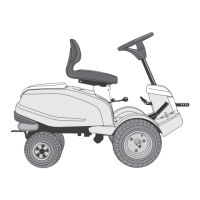ENGLISH
EN
1 GENERAL
This symbol indicates WARNING.
Personal injury and/or damage to
property may result if the instructions
are not followed carefully.
You must read these instructions for use
and the accompanying pamphlet
“SAFETY INSTRUCTIONS”
carefully, before starting up the
machine.
1.1 SYMBOLS
The following symbols appear on the machine.
They are there to remind you of the care and
attention required in use.
This is what the symbols mean:
Warning!
Read the instruction manual and the safety
manual before using the machine.
Warning!
Watch out for discarded objects. Keep
onlookers away.
Warning!
Always wear hearing protectors.
Warning!
This machine is not designed to be driven
on public roads.
Warning!
The machine, equipped with original
accessories, may not be driven on slopes
greater than 10º in any direction.
Warning!
Risk of burn injuries. Do not touch the
silencer.
1.2 GENERAL
This machine is available in two versions.
• Ready, manual transmission, designated
Ready.
• Ready, hydrostatic transmission, designated
Ready HST.
2 CONTROLS
Items 1 - 9, see figures 1 - 3.
2.1 Implement lifter, mechanical (1)
To switch between working position and transport
position:
1. Depress the pedal fully.
2. Release the pedal slowly.
2.2 SERVICE BRAKE/CLUTCH
(2, Ready)
A pedal that combines both service brake and
clutch. There are 3 positions:
1. Pedal released – forward drive
engaged. The machine will
move if a gear is engaged.
Service brake not activated.
2. Pedal depressed halfway –
forward drive disengaged, gear
shifting can be performed.
Service brake not activated.
3. Pedal fully depressed –
forward drive disengaged.
Service brake fully activated.
NOTE! You must never regulate the operating
speed by slipping the clutch. Use a suitable gear
instead, so that the right speed is obtained.
2.3 Clutch-parking brake
(2, Ready HST)
The pedal (3) has the following
three positions:
• Released. The clutch is not activated. The park-
ing brake is not activated.
• Depressed halfway. Forward drive disengaged.
The parking brake is not activated.
• Pressed down. Forward drive disengaged. The
parking brake is fully activated but not locked.
2.4 Inhibitor, parking brake (3)
The inhibitor locks the (2) pedal in the de-
pressed position. This function is used to
lock the machine on slopes, during trans-
port, etc.
The parking brake must always be re-
leased during operation.
Locking:
1. Depress the pedal (2) fully.
2. Move the inhibitor (3) up.
3. Release the pedal (2).
4. Release the inhibitor (3).
Unlocking:
Press and release the “clutch-brake” pedal.

